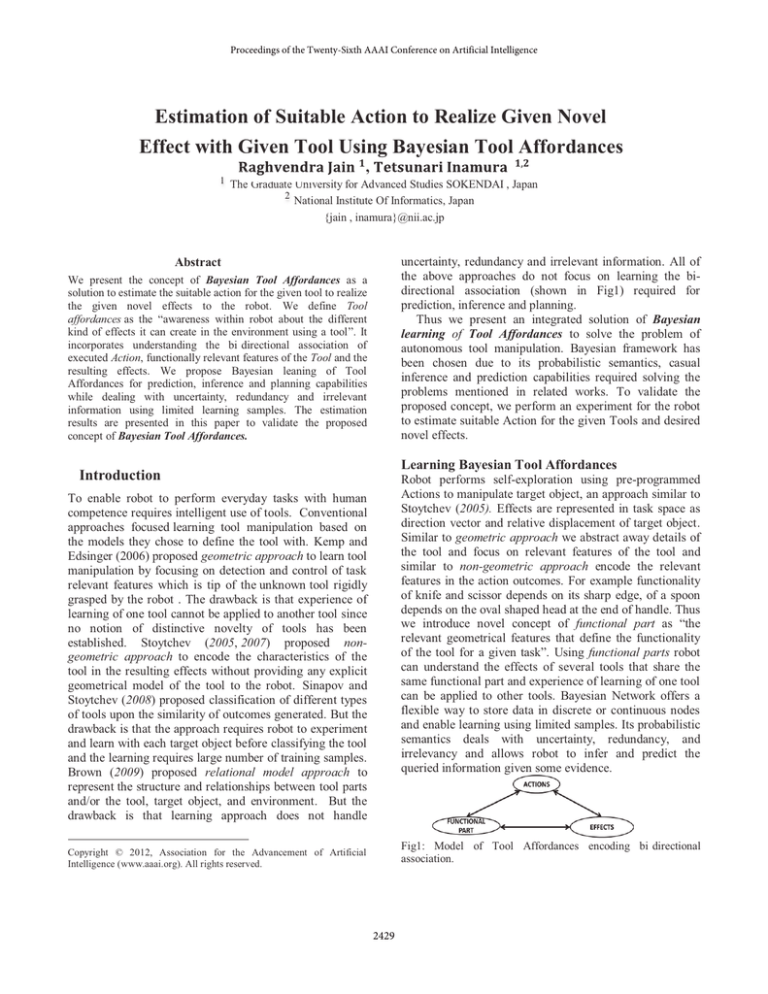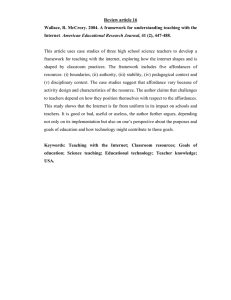
Proceedings of the Twenty-Sixth AAAI Conference on Artificial Intelligence
Estimation of Suitable Action to Realize Given Novel
Effect with Given Tool Using Bayesian Tool Affordances
,
1 The
The G
Graduate University for Advanced Studies SOKENDAI , Japan
2
Natiional
io
o Institute Of Informatics, Japan
{jain , inamura}@nii.ac.jp
uncertainty, redundancy and irrelevant information. All of
the above approaches do not focus on learning the bidirectional association (shown in Fig1) required for
prediction, inference and planning.
Thus we present an integrated solution of Bayesian
learning of Tool Affordances to solve the problem of
autonomous tool manipulation. Bayesian framework has
been chosen due to its probabilistic semantics, casual
inference and prediction capabilities required solving the
problems mentioned in related works. To validate the
proposed concept, we perform an experiment for the robot
to estimate suitable Action for the given Tools and desired
novel effects.
Abstract
We present the concept of Bayesian Tool Affordances as a
solution to estimate the suitable action for the given tool to realize
the given novel effects to the robot. We define Tool
affordances as the “awareness within robot about the different
kind of effects it can create in the environment using a tool”. It
incorporates understanding the bi directional association of
executed Action, functionally relevant features of the Tool and the
resulting effects. We propose Bayesian leaning of Tool
Affordances for prediction, inference and planning capabilities
while dealing with uncertainty, redundancy and irrelevant
information using limited learning samples. The estimation
results are presented in this paper to validate the proposed
concept of Bayesian Tool Affordances.
Learning Bayesian Tool Affordances
Introduction
Robot performs self-exploration using pre-programmed
Actions to manipulate target object, an approach similar to
Stoytchev (2005). Effects are represented in task space as
direction vector and relative displacement of target object.
Similar to geometric approach we abstract away details of
the tool and focus on relevant features of the tool and
similar to non-geometric approach encode the relevant
features in the action outcomes. For example functionality
of knife and scissor depends on its sharp edge, of a spoon
depends on the oval shaped head at the end of handle. Thus
we introduce novel concept of functional part as “the
relevant geometrical features that define the functionality
of the tool for a given task”. Using functional parts robot
can understand the effects of several tools that share the
same functional part and experience of learning of one tool
can be applied to other tools. Bayesian Network offers a
flexible way to store data in discrete or continuous nodes
and enable learning using limited samples. Its probabilistic
semantics deals with uncertainty, redundancy, and
irrelevancy and allows robot to infer and predict the
queried information given some evidence.
To enable robot to perform everyday tasks with human
competence requires intelligent use of tools. Conventional
approaches focused learning tool manipulation based on
the models they chose to define the tool with. Kemp and
Edsinger (2006) proposed geometric approach to learn tool
manipulation by focusing on detection and control of task
relevant features which is tip of the unknown tool rigidly
grasped by the robot . The drawback is that experience of
learning of one tool cannot be applied to another tool since
no notion of distinctive novelty of tools has been
established. Stoytchev (2005, 2007) proposed nongeometric approach to encode the characteristics of the
tool in the resulting effects without providing any explicit
geometrical model of the tool to the robot. Sinapov and
Stoytchev (2008) proposed classification of different types
of tools upon the similarity of outcomes generated. But the
drawback is that the approach requires robot to experiment
and learn with each target object before classifying the tool
and the learning requires large number of training samples.
Brown (2009) proposed relational model approach to
represent the structure and relationships between tool parts
and/or the tool, target object, and environment. But the
drawback is that learning approach does not handle
Fig1: Model of Tool Affordances encoding bi directional
association.
Copyright © 2012, Association for the Advancement of Artificial
Intelligence (www.aaai.org). All rights reserved.
2429
Actions : A
Functional
Parts :F
:Contract Arm
:Slide Arm Left
:Pull Diagonally 1
:Pull Diagonally 2
Output: Probabilityy for suitable Action P(A)= P(A F, E )
Table 1: Formalism of Tool Affordances. The salient changes
between observations over time are Effects (E).
Effects : E
{
:
Relative displacement
of target object after
manipulation
:Corner
:Verticall
:Horizontal
Direction
traversal
of
:
target
Table 2: Data representing Tool Affordances (refer Table 1)
Effect Corresponding Target direction
A,F
,
,
,
,
Plot1: P(A) P(A|
,E)
Plot2:: P(A)
P
Plot
Plot2
P(A
A)) P( |
Plo
Plot3:
P
ot3:
o P(A) P(A
P(A||
,E)
,E)
Fig3: Inputs to Bayesian Tool Affordances are effects to
(horizontal
axis) and functional parts
during evaluation and
vertical left axis represent the probability of the Actions given Effects and
functional part as evidence
Experiments, Results and Discussion
For each pair of Action and functional Part shown in Table
2, a total of 240 times target object is manipulated. Target
object which is a cube is placed randomly at different
positions within the workspace to include variations in the
data .A random force corresponding to each Action is
applied on the tool resulting in target displacement using
functional part and effects are recorded. The entire process
. The structure of Bayesian
is simulated using
network is shown in Fig2. For learning 160 samples
,
are used while remaining
of
80 samples are kept for evaluation along with 80 samples
which represent the novel effects. Thus in total
of
we have 320 evaluation samples.
Conclusion and Future Work
We proposed the concept of learning Bayesian Tool
Affordances focusing of functional parts of the tool to
solve the problem of autonomous tool manipulation. We
addressed the problem of estimation of suitable Action
given the desired effects and the functional parts. In future,
we plan to study how robot can find functional parts using
a combination of eye gaze, interactive communication, and
imitation and computer vision.
References
Brown, S. (2009). A relational approach to tool-use learning in robots.
Ph.D. thesis, School of Computer Science and Engineering, The
University of New South Wales, Sydeney.
C. Huang and A.Darwiche (1996) . Inference in belief networks: A
procedural guide . International Journal of Approximate Reasoning, 15(3)
: 225-263
Christopher M. Bishop (2007) . Pattern Recognition and Machine
Learning (Information Science and Statistics ) . Springer.
Kemp, C. C., & Edsinger, A. (2006). Robot manipulation of human tools:
Autonomous detection and control of task relevant features. In
Proceedings of the fifth international conference on development and
learning, special session on classifying activities in manual tasks
Fig2: The Bayesian Network structure for Tool Affordances.
Box represents nodes storing discrete data and ovals the
continuous data. We use Maximum Likelihood parameter
estimation (Christopher M. Bishop 2007) to adjust weight
parameters along the connection during learning and
Junction Tree algorithm (C. Huang and A. Darwiche 1996)
for inference during evaluation.
The estimation of suitable Action to realize given effects
using the given functional part is shown in Fig3. It shows
using all given functional
that robot estimates Action
which seems quite likely
parts to bring the novel effect
by looking at the pictogram depicting corresponding target
direction as shown in Table 2.
Stoytchev, A. (2005). Behaviour-grounded representation of tool
affordances. In Proceedings of IEEE International Conference on
Robotics and Automation (ICRA), pp. 3071-3076
Stoytchev, A. (2007). Robot tool behaviour: A developmental approach to
autonomous tool use. Ph.D. thesis, College of Computing, Georgia
Institute of Technology, Atlanta.
Sinapov, J., & Stoytchev, A. (2008). Detecting the functional similarities
between tools using a hierarchical representation of outcomes. In
Proceedings of the IEEE conference on development and learning (ICDL
2008), France.
1. www.cyberbotics.com
1
2430





